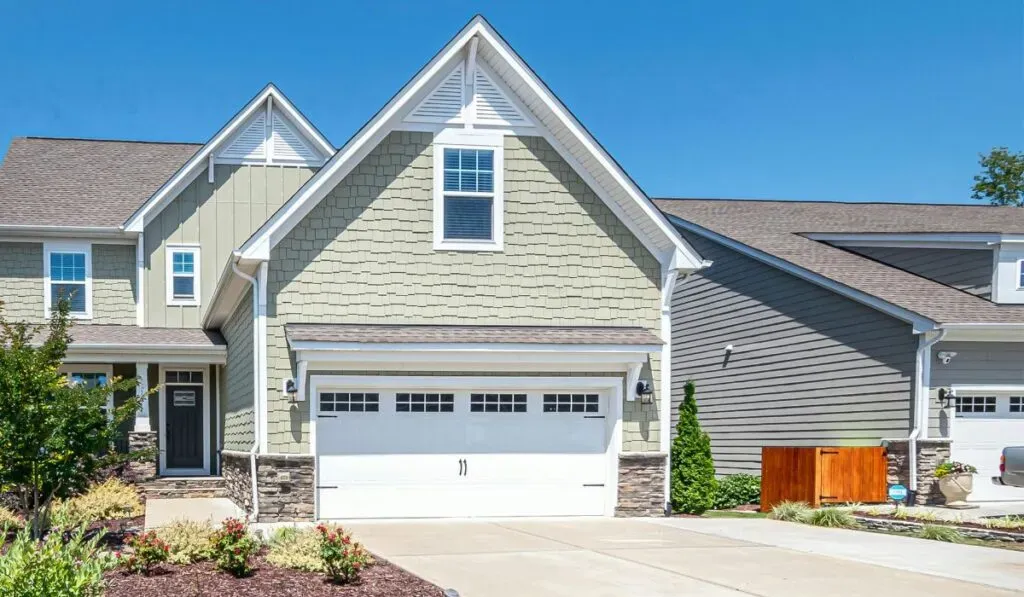
Comfort, Noise, and ROI are key factors when choosing the right garage door for your home. Insulated garage doors offer better temperature moderation, garage door noise reduction, and higher R-values compared to non-insulated options, improving comfort and long-term ROI with benefits like polyurethane or polystyrene insulation.
Understanding Insulated and Non-Insulated Garage Doors
Garage doors can have insulation or none at all. This affects comfort, noise, and energy use. In Southern California, the weather can change a lot. So, knowing the difference helps you pick the right door.
Insulated garage doors keep heat from moving through the door. They help keep your garage cooler in summer and warmer in winter. That saves energy bills and makes things comfy.
Non-insulated doors don’t have any stuff inside to block heat or sound. They let noise in and out more easily. Plus, they don’t stop hot or cold air well.
Here are some key points about insulated garage doors:
- They use garage door insulation types like foam panels.
- Garage door thermal breaks stop heat from moving through metal parts.
- Thermal break technology helps improve energy efficiency.
- The R-value garage doors show how good they are at blocking heat.
- Sound transmission class (STC) ratings garage doors tell how well they block noise.
- Lower decibel noise levels mean a quieter garage.
- Materials with low thermal conductivity keep heat flow low.
What is an Insulated Garage Door?
An insulated garage door has layers of material inside it. These layers block heat and sound better than plain metal. Many folks in Southern California pick these because of the hot summers and cool winters.
These doors often use foam inside. Foam works great to keep temps steady. Two popular kinds are polystyrene and polyurethane.
Here’s what you should know about insulation foam for doors:
- It slows down heat transfer through the door.
- It cuts down noise when the door opens or closes.
- It can add strength to the door too.
Using insulated garage doors Southern California homes benefit by saving on cooling and heating costs. It also makes the garage a better space to work or hang out.
What is a Non-Insulated Garage Door?
Non-insulated garage doors have no extra materials inside them for heat or sound blocking. Usually, they’re made from a single layer of steel or aluminum sheet with no foam or thermal breaks inside.
These tend to be lighter but offer little help against outside weather changes or noise pollution.
Characteristics and limitations of non-insulated garage doors
Non-insulated doors can get noisy when opening or closing since they lack sound-dampening parts. They don’t help much to control temperature either.
Some other points:
- They cost less up front but may raise heating/cooling bills later.
- Less protection from extreme hot or cold days means your garage feels uncomfortable more often.
- Noise from street or neighbors goes through easier because of poor sound barrier features.
So while non-insulated garage doors may save money at first, their limits show up over time with comfort issues and higher energy use.
Benefits of Insulated Garage Doors in Southern California
Insulated garage doors in Southern California bring a lot of perks. They cut down on heat moving between your garage and home. These energy-efficient garage doors help save energy by keeping your home’s temperature steady.
You get clear home comfort zones—cooler inside during hot months, warmer when it’s cold out. Plus, they guard your garage environment from extreme temps, moisture, and pests that Southern California often has.
Choosing insulated doors over plain ones means your home works better. They protect your stuff like tools or gym gear from damage. The U.S. Department of Energy says good insulation can lower heating and cooling costs by about 15%. That’s a solid reason to pick these doors for local homes.
Enhanced Comfort in Southern California’s Climate
Southern California’s weather changes a lot between seasons. Summers get hot, winters can be cool. Keeping a stable garage temperature is key. Insulated garage doors help by blocking cold air in winter and hot air in summer.
They stop drafts that sneak through regular doors without insulation. This keeps the garage temperature more steady all year long. Your HVAC system won’t have to work so hard either because less heat escapes through the garage walls.
Here’s why this matters:
- Blocks cold air on chilly nights
- Keeps hot air out during summer days
- Reduces drafts and chills
- Protects belongings from harsh weather
Even cheaper polystyrene panels add real value versus no insulation at all. Using higher R-value materials like polyurethane boosts these savings more, making it a smart choice for any budget.
Benefits of Non-Insulated Garage Doors

Non-insulated garage doors have some clear perks, especially if you’re watching your budget. They usually cost less than insulated ones, which makes them a popular pick for folks wanting to save cash upfront. The U.S. Department of Energy says these doors have low R-values—around R-0 to R-1—so they don’t stop heat much. But that’s fine in the right situations.
These doors are lighter, so you can open them by hand easier and your opener won’t work as hard. This can mean fewer repairs later on. Also, they tend to look simple with fewer layers. That’s good if you like things plain or need a quick fix.
You won’t get much noise blocking or energy savings with non-insulated doors. But if you mostly store stuff in your garage and don’t spend much time there, that’s okay.
If you compare garage door cost comparison, non-insulated types are cheaper upfront and still do the job well enough. Just keep in mind that if your garage connects to your home, losing heat might cost more in the long run.
Cost-Effectiveness
Non-insulated garage doors come with a smaller price tag at first. They usually cost between $500 and $1,000 to install depending on size and material quality. Insulated doors often cost over $1,200 because of extra stuff inside like foam cores.
This lower price makes non-insulated doors good for people who want to save now without giving up safety or basic use.
Here’s a quick list of why some choose non-insulated doors for cost reasons:
- Lower upfront cost
- Simple installation
- Basic protection
But a quick cost-benefit analysis shows the trade-off: you might spend more on heating or cooling if your garage needs good temperature control.
At the end of the day, picking insulated vs non‑insulated garage doors is about balancing your budget now with what you want for energy savings later.
Suitability for Detached Garages
Non-insulated garage doors fit well with detached garages. These garages stand separate from the house and don’t affect your home’s indoor temperature much. So spending big bucks on insulation there doesn’t help much.
In mild climates like Southern California’s, detached garages handle normal weather without extra insulation just fine. The usual steel or aluminum panels hold up against sun and breezes without trouble.
Plus, detached garages often store cars or tools only. Noise isn’t usually a problem since no one’s living right next door.
Here are some reasons non-insulated doors suit detached garages:
- Less impact on home energy bills
- Handles moderate weather well
- No need for high noise reduction
Garage Usage and Purpose – Choosing the Right Insulation
What you use your garage for changes which insulation works best:
- Residential Garages: Regular car storage works well with basic foam-insulated steel or wood doors.
- Garage Workspaces: Workshops or hobbies do better with steel doors that have higher R-values for stronger temp control.
- Home Gyms & Pet Areas: Wooden insulated doors with foam keep noise down and temps comfy.
Foam types vary mainly between polystyrene and polyurethane. Polystyrene is cheaper but has lower R-values. Polyurethane costs more but insulates better.
Steel insulated doors are tough and handle active spaces like gyms well. Wood insulated doors look nicer and fit quieter uses like pet rooms or art studios.
- Steel doors last longer and offer strong insulation
- Wood doors add style plus decent thermal protection
- Foam options balance cost vs insulation strength
- Choose based on how you plan to use the space
Are Insulated Garage Doors Worth the Investment in Southern California?
If you live in Southern California, insulated garage doors can be a smart buy. They help keep your home cooler in summer and warmer in winter. These doors also cut down noise and make your home more comfy. Buyers notice these things, so insulated doors can boost your garage door resale value.
The U.S. Department of Energy says insulated garage doors can save you up to 15% on heating and cooling bills. Sure, these doors cost more upfront than regular ones. But over time, the energy savings make up for the price difference.
Home remodeling experts rank new garage doors as one of the best ways to improve home resale value and curb appeal. So, when you buy an insulated garage door, you get more than just a door—you add value to your home.
How Insulated Garage Doors Increase Resale Value
Garage door resale value depends a lot on looks and quality. In Southern California’s market, curb appeal is king. A nice-looking insulated garage door makes your home stand out.
Here are some popular choices:
- Insulated steel garage doors: Tough and modern. They resist dents better than wood and have good insulation with R-values from 6 to 12.
- Insulated wooden garage doors: Look classic and warm. They keep heat better than plain wood but need more care.
Both types improve how your house looks outside. They show buyers you care about energy savings too. Real estate pros say homes with updated insulated garage doors sell faster—and often at higher prices.
Making the Right Choice for Your Southern California Home
Picking between insulated and non-insulated garage doors matters a lot for your home’s comfort and energy use here in Southern California. The weather is usually mild, but temps still change enough to affect your garage’s temperature. Insulated doors help keep the garage temperature stable. They block heat on hot days and hold warmth when it gets cooler at night. This makes areas near or above the garage more comfy.
Insulated doors give better garage door ROI in Southern California, making a high-quality garage door replacement a smart investment for your home. They cut down on heating and cooling costs by stopping air leaks and slowing heat transfer. This means you save money over time and add value if you remodel or upgrade your home, especially if you connect living spaces to the garage.
Non-insulated doors might work fine if your garage is just for storage and temp control isn’t important. But they don’t reduce noise like insulated ones do, which can be a big deal near bedrooms or living rooms.
Recap of Key Factors
- Insulated Garage Doors Southern California: Keep indoor temps steady despite outside weather.
- R-value Garage Doors: A higher R-value means better insulation; polyurethane usually has higher R-values than polystyrene.
- Polystyrene vs Polyurethane Comparison: Polyurethane is denser, lasts longer, and blocks noise better than polystyrene’s lighter foam.
- Energy-Efficient Garage Doors: Help lower bills while making your home more comfortable.
- Noise Reduction Benefits: Insulation helps block sound from outside, useful in noisy neighborhoods.
- Long-Term Investment: Insulated doors boost property value by improving look and function.
Ready for expert advice or a free quote on your next new garage door installation in Southern California? Contact 24/7 Garage Door Repair, your local professionals in energy-efficient installations, repairs, and maintenance tailored for lasting comfort and savings.
